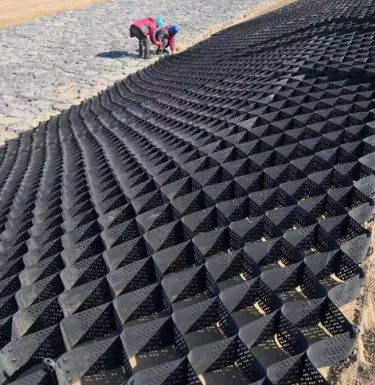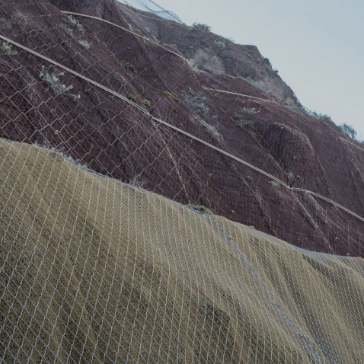- Understanding the Role of Geomembrane Liners in Waste Management
- Innovations in Geomembrane Liners for Water Management
- Geomembrane Liners: A Comprehensive Guide
- The Future of Geomembrane Liners in Civil Engineering
- Geomembrane Liners: Enhancing Landfill Stability
Manager:Alvin Wang
WhatsApp:+62 8983806051
Tel:+86 10-5797-1075
Email:steelwang@okorder.com
Address:3rd Floor, No.2 Building, No.1 Sanlihe Road
What is the maximum slope for geocell?
Geocell slope protection has become an increasingly popular method for stabilizing and protecting slopes in various engineering projects. With its versatility and effectiveness, geocell slope protection has proven to be a reliable solution for managing erosion and maintaining the integrity of slopes in both civil and environmental applications. However, one question that frequently arises in discussions surrounding geocell slope protection is: What is the maximum slope for geocell?

Understanding Geocell Slope Protection
Before delving into the maximum slope considerations, it's essential to grasp the fundamentals of geocell slope protection. Geocells, also known as cellular confinement systems, are three-dimensional, honeycomb-like structures made from high-density polyethylene (HDPE) or other durable materials. These cells are interconnected and filled with soil, aggregate, or other infill materials to create a stable and reinforced structure.
Geocell slope protection utilizes these cellular confinement systems to mitigate erosion, prevent landslides, and stabilize slopes. By confining and reinforcing the soil or aggregate within the cells, geocells distribute loads evenly, enhance soil shear strength, and promote vegetation growth. This innovative approach offers cost-effective and environmentally friendly solutions for slope stabilization projects.
Factors Influencing Maximum Slope for Geocell
Several factors influence the maximum slope for geocell installations. Understanding these factors is crucial for determining the feasibility and effectiveness of using geocells in slope protection projects:
1. Soil Characteristics: The type and properties of the soil on the slope significantly impact the maximum slope angle suitable for geocell installation. Cohesive soils, such as clay, generally offer greater stability compared to cohesionless soils like sand or gravel.
2. Geocell Design: The design and configuration of the geocell system play a critical role in determining its maximum slope capabilities. Factors such as cell size, cell wall height, and the spacing between cells influence the overall stability and load-bearing capacity of the geocell structure.
3. Slope Geometry: The slope's geometry, including its angle of inclination, height, and surface roughness, affects the performance of geocell slope protection systems. Steeper slopes may require additional reinforcement and specialized design considerations to ensure stability and effectiveness.
4. Environmental Conditions: Environmental factors such as rainfall, temperature fluctuations, and seismic activity can impact slope stability and the performance of geocell installations. Proper drainage and erosion control measures must be integrated into the design to mitigate these effects.
5. Loading Conditions: The anticipated loading conditions, including static and dynamic loads, must be carefully evaluated when determining the maximum slope for geocell applications. Heavy rainfall, vehicular traffic, or other external forces can exert additional pressure on the slope, necessitating appropriate reinforcement.
Determining the Maximum Slope Angle
While there is no universal maximum slope angle for geocell installations due to the variability of project-specific factors, engineers typically consider several key criteria when determining the suitability of geocell slope protection for a particular slope:
1. Safety Factor: Ensuring the safety and stability of the slope is paramount. Engineers calculate the factor of safety based on factors such as soil strength, slope geometry, and anticipated loads to determine the maximum allowable slope angle for geocell installation.
2. Stability Analysis: Conducting comprehensive stability analyses, including slope stability modeling and geotechnical assessments, helps engineers assess the effectiveness of geocell slope protection under various conditions. These analyses consider factors such as soil shear strength, pore water pressures, and potential failure mechanisms.
3. Field Testing and Monitoring: Field testing and monitoring are essential components of evaluating the performance of geocell slope protection systems in real-world conditions. Monitoring factors such as slope deformation, soil erosion, and vegetation growth provides valuable data for refining design parameters and assessing long-term stability.
4. Regulatory Compliance: Compliance with regulatory requirements and industry standards is essential for ensuring the safety and environmental sustainability of slope protection projects. Engineers must adhere to relevant guidelines and specifications governing geocell installation and slope stabilization practices.
Case Studies: Successful Applications of Geocell Slope Protection
Numerous case studies demonstrate the effectiveness of geocell slope protection in a variety of settings:
1. Highway Embankment Stabilization: Geocells were used to reinforce highway embankments with steep slopes, effectively preventing soil erosion and reducing maintenance costs.
2. Coastal Erosion Control: Geocell systems were employed along coastal areas prone to erosion, providing durable and environmentally friendly solutions for shoreline protection.
3. Landfill Slope Stabilization: Geocells were utilized to stabilize slopes in landfill sites, enhancing slope stability and preventing soil displacement.
4. Mining Reclamation: Geocells facilitated the reclamation of mined areas by stabilizing steep slopes and promoting vegetation establishment, minimizing environmental impact and restoring habitat functionality.

Conclusion
Geocell slope protection offers a versatile and sustainable solution for stabilizing and protecting slopes in various engineering and environmental applications. While there is no fixed maximum slope angle for geocell installations, engineers evaluate factors such as soil characteristics, geocell design, slope geometry, environmental conditions, and loading conditions to determine the suitability and safety of using geocells in slope protection projects. Through careful planning, analysis, and monitoring, geocell slope protection systems can effectively mitigate erosion, prevent landslides, and enhance slope stability, contributing to the resilience and sustainability of infrastructure and natural landscapes."
- Previous:What is a Geocell driveway?
- Next:What is the history of Geocell?






